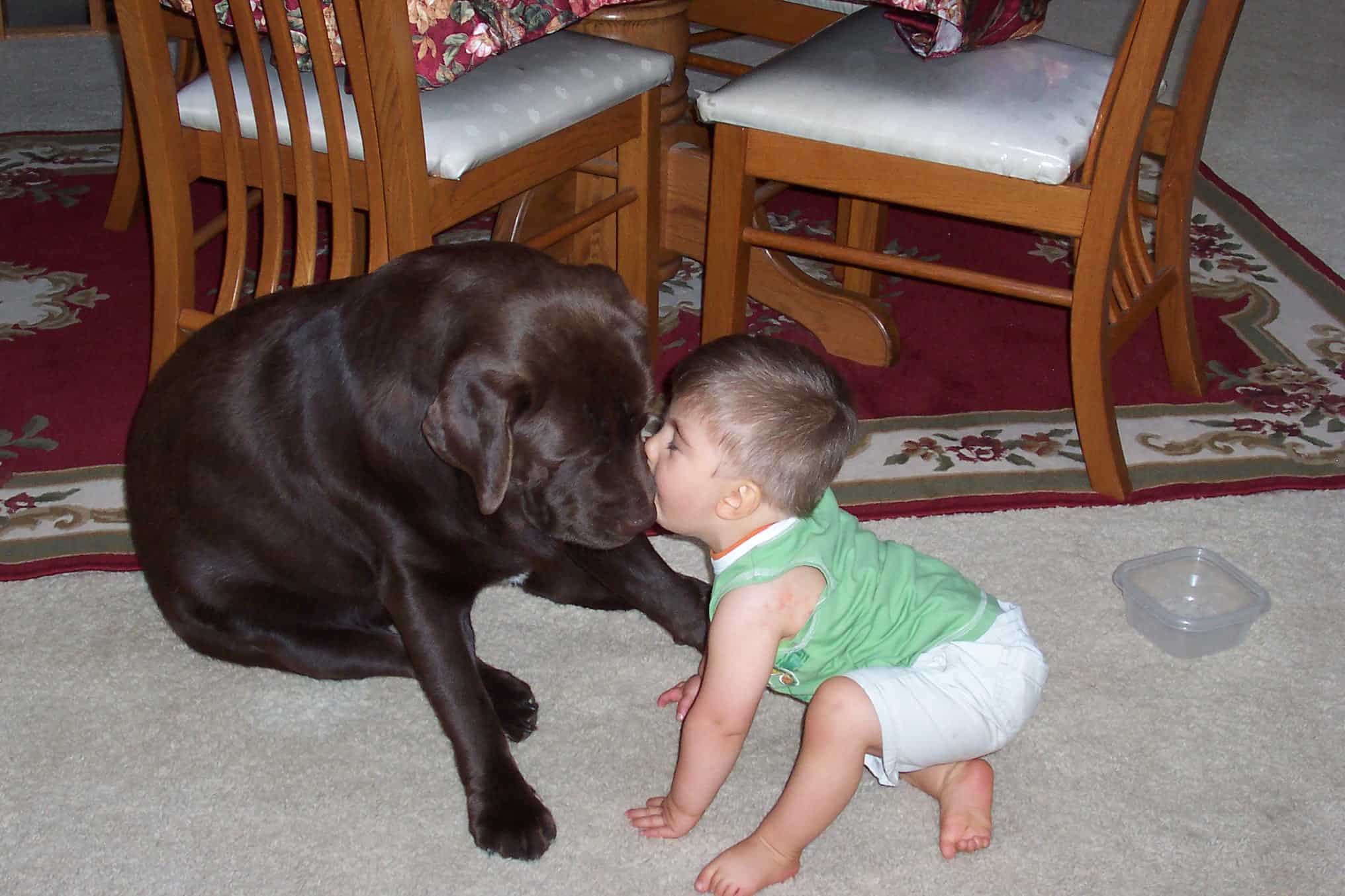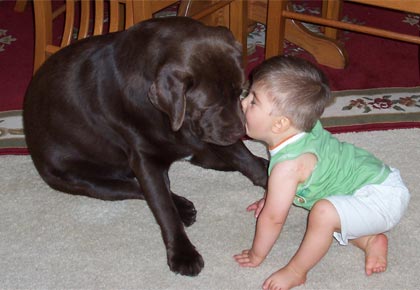When should I vaccinate my dog?

Vaccine Protocol/Schedule for puppies and Dogs
Dr. W. Jean Dodd’s vaccination protocol is now being adopted by ALL 27 North American veterinary schools. I highly recommend that you read this. Copy and save it to your files. Print it and pass it out at dog fairs, cat shows, kennel club meetings, dog parks, give a copy to your veterinarian and groomer, etc., etc.* Get the word out.
VACCINATION NEWS FLASH
*I would like to make you aware that all 27 veterinary schools in North America are in the process of changing their protocols for vaccinating
dogs and cats. Some of this information will present an ethical &economic challenge to vets, and there will be skeptics.
Some organizations have come up with a political compromise suggesting vaccinations every 3 years to appease those who fear loss of income vs.
those concerned about potential side effects. Politics, traditions, or the doctor’s economic well being should not be a factor in medical decision.
NEW PRINCIPLES OF IMMUNOLOGY
“Dogs and cats immune systems mature fully at 6 months. If a modified live virus vaccine is given after 6 months of age, it produces an immunity which is good for the life of the pet (ie: canine distemper,parvo, feline distemper). If another MLV vaccine is given a year later, the antibodies from the first vaccine neutralize the antigens of the second vaccine and there is little or no effect. The titer is not “boosted” nor are more memory cells induced.” Not only are annual
boosters for parvo and distemper unnecessary, they subject the pet to potential risks of allergic reactions and immune-mediated hemolytic anemia. “There is no scientific documentation to back up label claims for annual administration of MLV vaccines.” Puppies receive antibodies through their mothers milk. This natural protection can last 8-14weeks. Puppies & kittens should NOT be vaccinated at LESS than 8weeks. Maternal immunity will neutralize the vaccine and
little protection (0-38%) will be produced. Vaccination at 6 weeks will, however, delay the timing of the first highly effective vaccine. Vaccinations given 2 weeks apart suppress rather than stimulate the immune system. A series of vaccinations is given starting at 8 weeks and given 3-4 weeks apart up to 16 weeks of age.Another vaccination given sometime after 6 months of age (usually at 1 year 4mo) will provide lifetime immunity.
CURRENT RECOMMENDATIONS FOR DOGS
Distemper & Parvo * “According to Dr. Schultz, AVMA, 8-15-95, when a vaccinations series given at 2, 3 & 4 months and again at 1 year with a
MLV, puppies and kitten program memory cells that survive for life, providing lifelong immunity.” Dr. Carmichael at Cornell and Dr. Schultz
have studies showing immunity against challenge at 2-10 years for canine distemper & 4 years for parvovirus. Studies for longer duration are pending. “There are no new strains of parvovirus as one mfg. would like to suggest. Parvovirus vaccination provides cross immunity for all types.” Hepatitis (Adenovirus) is one of the agents known to be a cause of kennel cough. Only vaccines with CAV-2 should be used asCAV-1 vaccines carry the risk of “hepatitis blue-eye” reactions &
kidney damage.**Bordetella Parainfluenza: Commonly called “Kennel cough” Recommended only for those dogs boarded, groomed, taken to dog shows, or for any reason housed where exposed to a lot of dogs. The intranasal vaccine provides more complete and more rapid onset of immunity with less chance
of reaction. Immunity requires 72 hours and does not protect from every cause of kennel cough. Immunity is of short duration (4 to 6 months).*
*RABIES There have been no reported cases of rabid dogs or cats in Harris, Montogomery or Ft. Bend Counties [Texas], there have been rabid skunks and bats so the potential exists. / It is a killed vaccineand must be given every year./*//
*Lyme disease_is a tick born disease which can cause lameness, kidney failure and heart disease in dogs. Ticks can also transmit the disease to humans. The
original Ft. Dodge killed bacteria has proven to be the most effective vaccine. Lyme disease prevention should emphasize early removal of ticks. Amitraz collars are more effective than Top Spot, as amitraz paralyzes the tick’s mouthparts preventing transmission of disease.
**VACCINATIONS NOT RECOMMENDED**
Multiple components in vaccines compete with each other for the immune system and result in lesser immunity for each individual disease as well
as increasing the risk of a reaction. Canine Corona Virus is only a disease of puppies. It is rare, self limiting (dogs get well in 3 days without treatment). Cornell & Texas A&M have only diagnosed one case each in the last 7 years. Corona virus does not cause disease in adult dogs.*
*Leptospirosis vaccine is a common cause of adverse reactions in dogs. Most of the clinical cases of lepto reported in dogs in the US are caused by serovaars (or types) grippotyphosa and bratsilvia. The vaccines contain different serovaars eanicola and ictohemorrhagica. Cross protection is not provided and protection
is short lived. Lepto vaccine is immuno-supressive to puppies less than 16 weeks.
/NEW RECOMMENDATIONS FOR CATS
Feline vaccine related Fibrosarcoma is a type of terminal cancer related in inflammation caused by rabies & leukemia vaccines. This cancer is thought to affect 1 in 10,000 cats vaccinated. Vaccines with aluminum adjuvant, an ingredient included to stimulate the immune system, have been implicated as a higher risk. We now
recommend anon-adjuvanted rabies vaccine for cats. Testing by Dr. Macy, Colorado State , has shown this vaccine to have the lowest tissue reaction and
although there is no guarantee that a vaccine induced sarcoma will not develop, the risk will be much lower than with other vaccines.*
*Program injectable 6 mo flea prevention for cats has been shown to be very tissue reactive & therefore has the potential of inducing an injection site fiborsarcoma. If your cats develops a lump at the site of a vaccination, we recommend that it be removed ASAP, within 3-12 weeks.*
*Feline Leukemia Virus Vaccine This virus is the leading viral killer of cats. The individuals most at risk of infection are young outdoor cats, indoor/outdoor cats and cats exposed to such individuals. Indoor only cats with no exposure to potentially infected cats are unlikely to become infected. All cats should be tested prior to vaccination. /Cats over one year of age are naturally immune to Fel.V whether they are vaccinated or not, so annual vaccination of adult cats is NOT necessary. The incubation period of Feline leukemia can be over 3 years, so if your cat is in the incubation state of the disease prior to vaccination, the vaccine will not
prevent the disease. *
/Feline Panleukopenia Virus Vaccine. Also called feline distemper is a highly contagious and deadly viral disease of kittens. It’s extremely hardy and is resistant
to extremes in temperature and to most available disinfectants. Although an effective treatment protocol is available, it is expensive to treat because of the serious nature of the disease and the continued presence of virus in the environment, vaccination is highly recommended for all kittens. Cats vaccinated at 6 month or older
with either killed or MLV vaccine will produce an immunity good for life. Adult cats do NOT need this vaccine./*
*/Feline Calicivirus/ Herpesvirus Vaccine. Responsible for 80-90% of infectious feline upper respiratory tract diseases. The currently available injectable vaccines will minimize the severity of upper respiratory infections, although none will prevent disease in all situations.* *Intranasal vaccines are more effective at preventing the disease entirely. Don’t worry about normal sneezing for a couple of days. Because intranasal vaccines produce an immunity of shorter durations,
annual vaccination is recommended.
VACCINES NOT RECOMMENDED
Chlamydia or pneumonitis. The vaccine produces on a short (2 month)duration of immunity and accounts for less than 5% of upper respiratory infections in cats. The risks outweigh the benefits.*
**
*Feline Infectious Peritonitis. A controversial vaccine. Most kittens that contract FIP become infected during the first 3 months of life. The vaccine is labeled foruse at 16 weeks. All 27 vet schools do not recommend the vaccine.*
Bordetella A new vaccine for feline bordetella has been introduced. Dr. Wolfe of Texas A&M says that bordetella is a normal flora and does not cause
disease in adult cats. Dr. Lappin of Colorado State says that a review of the Colorado State medical records reveals not one case diagnosed in 10 years.
NEW DEVELOPMENTS: Giardia is the most common intestinal parasite of humans inNorth America , 30% or more of all dogs & cats are infected with
giardia. It has now been demonstrated that humans can transmit giardiato dogs & cats & vice versa. *
Heartworm preventative must be given year-round in Houston .
*VACCINES BADLY NEEDED New vaccines in development include: Feline Immunodeficiency Virus and cat scratch fever vaccine for cats and
Ehrlichia [one of the other tick diseases, much worse than Lymes] for dogs.
THE VIEW FROM THE TRENCHES; BUSINESS ASPECTS
Most vets recommend annual boosters and most kennel operators require them. For years the pricing structure of vets has misled clients into thinking that the inherent value of an annual office visit was in the “shots” they failed to emphasize the importance of a physical exam for early detection of treatable diseases. It is my hope that you will continue to require rabies & Kennel cough and emphasize the importance of a recent vet exam. I also hope you will accept the new protocols and
honor these pets as currently vaccinated. Those in the boarding business who will honor the new vaccine protocols can gain new customers who were
turned away from vet owned boarding facilities reluctant to change.
CONCLUSION
Dogs & cats no longer need to be vaccinated against distemper, parvo, & feline leukemia every year. Once the initial series of puppy or kitten vaccinations and first annual vaccinations are completed, immunity from MLV vaccines persists for life. It has been shown that cats over 1 year of age are immune to Feline Leukemia whether they have been vaccinated or not. Imagine the money you will save, not to mention less risks from side effects. PCR rabies vaccine, because it is not adjuvanted, will mean less risk of mediated hemolytic anemia and allergic reactions are reduced by less frequent use of vaccines as well as by avoiding unnecessary vaccines such as K-9 Corona virus and chlamydia for cats, as well as ineffective vaccines such as Leptospirosis and FIP. Intranasal vaccine for Rhiotracheitis and Calici virus, two upper respiratory viruses of cats provide more complete protection than injectable vaccines with less risk of serious reactions.
The AAHA and all 27 veterinary schools of North America are our biggest endorsement for these new protocols.*
*Dr. Bob Rogers* Please consider as current on all vaccinations for boarding purposes.
DOGS Initial series of puppy vaccines
- distemper, hepatitis, parvo, parinfluenze – 3 sets one month apart concluding at 16 weeks of age.*
- Rabies at 16 weeks of age (later is better)
- Bordetella within last 4-6 months First annual (usually at 1 year and4 months of age)*
- DHP, Parvo, Rabies
- Bordetella within last 4-6 months 2 years or older
- Rabies with in last year
- Bordetella within last 4-6 months
- DHP & Parvo given anytime over 6 months of age , but not necessarily within the last year.
- Recommended: Physical exam for transmissible diseases and health risks.
- ***Some vets will now check titers before vaccinating…many are not taking this route so we are not vaccinating when not needed.
[youtube width=”1000″ height=”625″]https://www.youtube.com/watch?v=Wfu1BCfpzP8[/youtube]


5 Comments